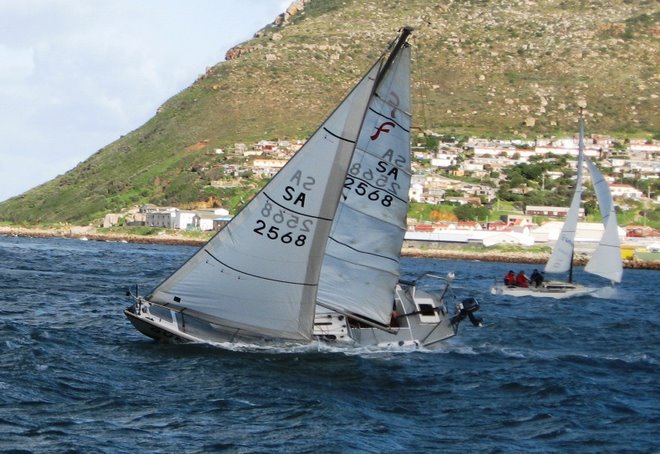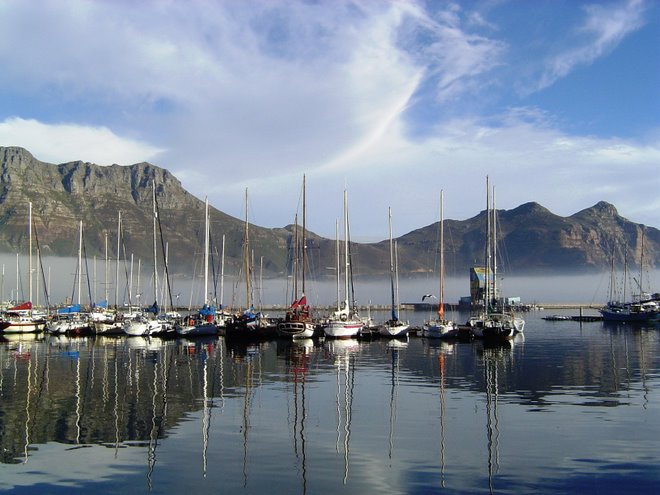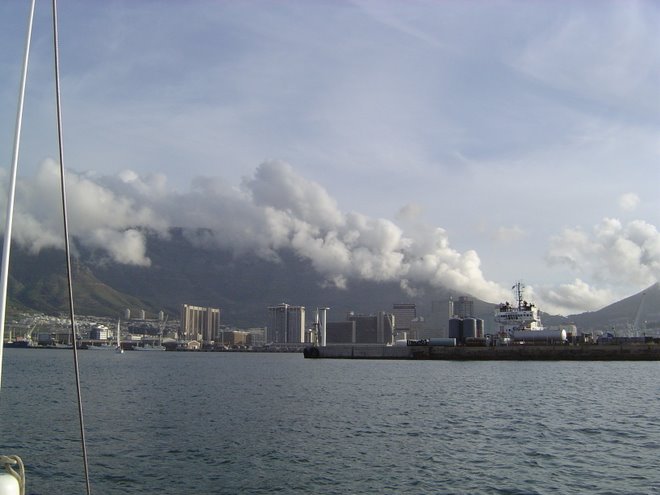The Flamenca was a fairly modern design for her time - being moderate/light displacement, fin keel, and spade rudder. The Flamenca was conceived at a time when sloop rigs favoured a dominant headsail, and allowed a fairly simple rig without much need for running backstays etc. Her proportions are moderate in every sense, with a narrow stern, and relatively low freeboard. For a small boat, she is drier than one might expect, as the bow is able to rise over chop and headwaves - due to fairly generous rocker on the underbody (i.e. she is not long and flat underneath). Downside of this is she won't plane easily or at all perhaps. She has a fair whack of ballast in the cast-iron keel - and a respectable displacement of around 2000 kgs. Berkemeyer estimates her AVS at about 140 deg, and certainly she feels very stiff in strong winds. For all her seaworhiness and seakindliness - these are not high-performance boats. They are slightly under-canvassed in light winds, but are fairly safe in the challenging conditions of the Cape waters. Quest is able to reach 6.5 knots beating (given 12 knots or more), and about 7.5 knots on a broad reach - both of which are in fact higher than her theoretical hull speed. Tacking angles are  not too bad but not great - mainly due to the poor sheeting angles for the genoa, limited by the position of the shrouds. I have recently fitted some barber-haulers to improve the sheeting angles. I think the rounded hull is also plays against this - compared with say an RCOD which not only makes better angles but also appears to make less leeway - it seems to me. But overall quite respectable performance for a small boat, and downwind she does remarkably well - perhaps a bit suprisingly. Overall, she seems to have the same performance as the Sadler-26 I would say.
not too bad but not great - mainly due to the poor sheeting angles for the genoa, limited by the position of the shrouds. I have recently fitted some barber-haulers to improve the sheeting angles. I think the rounded hull is also plays against this - compared with say an RCOD which not only makes better angles but also appears to make less leeway - it seems to me. But overall quite respectable performance for a small boat, and downwind she does remarkably well - perhaps a bit suprisingly. Overall, she seems to have the same performance as the Sadler-26 I would say.
 not too bad but not great - mainly due to the poor sheeting angles for the genoa, limited by the position of the shrouds. I have recently fitted some barber-haulers to improve the sheeting angles. I think the rounded hull is also plays against this - compared with say an RCOD which not only makes better angles but also appears to make less leeway - it seems to me. But overall quite respectable performance for a small boat, and downwind she does remarkably well - perhaps a bit suprisingly. Overall, she seems to have the same performance as the Sadler-26 I would say.
not too bad but not great - mainly due to the poor sheeting angles for the genoa, limited by the position of the shrouds. I have recently fitted some barber-haulers to improve the sheeting angles. I think the rounded hull is also plays against this - compared with say an RCOD which not only makes better angles but also appears to make less leeway - it seems to me. But overall quite respectable performance for a small boat, and downwind she does remarkably well - perhaps a bit suprisingly. Overall, she seems to have the same performance as the Sadler-26 I would say. The cabin is a bit cramped compared with modern boats. No standing headroom. Depending on layout one could have up to six full-size berths but heaven knows why. There is no heads compartment - Quest has a portaloo just below the (deck-stepped) mast. I think one person could live in such a boat, and two people could share for brief periods.
The cabin is a bit cramped compared with modern boats. No standing headroom. Depending on layout one could have up to six full-size berths but heaven knows why. There is no heads compartment - Quest has a portaloo just below the (deck-stepped) mast. I think one person could live in such a boat, and two people could share for brief periods. Quest has a gas cooker - on 2-axis gimbals, which works really well at all angles of heel. The 3lb gas bottle acts as the pendulum weight. Not great to have gas in the boat, but then again there are no pipes or fittings.
Quest has a gas cooker - on 2-axis gimbals, which works really well at all angles of heel. The 3lb gas bottle acts as the pendulum weight. Not great to have gas in the boat, but then again there are no pipes or fittings.The hull is made of GRP. Most were made by Nebe in Hout Bay - though Quest was made by an "H. Vink" in Natal somewhere I think. I think she was made in about 1988 or so - and build quality is generally good. She has some slight osmosis but nothing to be concerned about. Action Yachting gave her a good workover a year or two ago - and found nothing to be concerned about. A more recent anti-fouling showed no deterioration at all. I think she'll last me another twenty years before the hull needs any work.
 Quest has an outboard (see the dolphins in the pic). Outboards are great if you want to avoid the complications of inboards -and also much lighter and cheaper. But they are not really effective in a big chop - and a nuisance to ship and unship each time (as they tend to get swiped). An outboard in a well must be the ideal solution I think - but the well must be designed by a genius, and not too intrusive in the cockpit. That would be ideal . . . as it is my little Yamaha 5hp is fine for most situations, and drives the hull at 4.5 knots easily under half throttle. Full throttle gives about 5.5 knots. In fact there is a large space under the cockpit floor where a decent inboard could be fitted - ideally with a saildrive. That would be nice - but over-capitalising on a small boat like this.
Quest has an outboard (see the dolphins in the pic). Outboards are great if you want to avoid the complications of inboards -and also much lighter and cheaper. But they are not really effective in a big chop - and a nuisance to ship and unship each time (as they tend to get swiped). An outboard in a well must be the ideal solution I think - but the well must be designed by a genius, and not too intrusive in the cockpit. That would be ideal . . . as it is my little Yamaha 5hp is fine for most situations, and drives the hull at 4.5 knots easily under half throttle. Full throttle gives about 5.5 knots. In fact there is a large space under the cockpit floor where a decent inboard could be fitted - ideally with a saildrive. That would be nice - but over-capitalising on a small boat like this. For her size, Quest has a fairly generous cockpit. Easily seats four (if motoring for example). But whilst sailing - I just find one in the cockpit is enough - as one wants to have the tiller and the mainsheet in the hands of the helmsman. Maybe it's just my dinghy heritage showing here - because in fact it does work quite well if the sail trimmer sits forward and helmsman sits back.
For her size, Quest has a fairly generous cockpit. Easily seats four (if motoring for example). But whilst sailing - I just find one in the cockpit is enough - as one wants to have the tiller and the mainsheet in the hands of the helmsman. Maybe it's just my dinghy heritage showing here - because in fact it does work quite well if the sail trimmer sits forward and helmsman sits back. Is there any other boat in this class I would rather have? I would have to say the Sadler 26. Most of the virtues of a Flamenca, but considerably more space and comfort. Plus they are unsinkable, and usually have inboards. And they cost about 3x more - but still quite affordable really. They are safe, have good manners, and good for shorthanding.
I reckon I'll get a bigger boat when I go cruising. Until then - the enjoyment of sailing - for me anyway - is more about improving my skills, and getting the most from the boat (any boat). In many ways small boats are more challenging than big boats -at sea. Quest is great for singlehanding. She is also great for sailing onto the mooring (i.e. quite cheap!). One doesn't want to practise this in a new Shearwater for example. And, she has quite favourable PHRF rating!





